The 2000 Census reported that Ellsworth's population
was 531.
The Ellsworth Kum & Go Travel Plaza near
Interstate 35 was constructed in 2005.

The railroad tracks from Jewell through Ellsworth were
removed in 2006
according to Union Pacific's master plan.
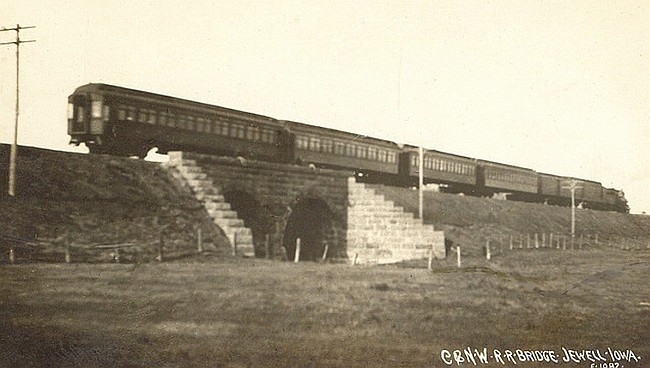
(Click image for a different view of this railroad
bridge.)
The railroad bridge at the east end of Jewell allows
the railroad to cross
the dredge ditch coming from the north. This
image may be from the 1940s.
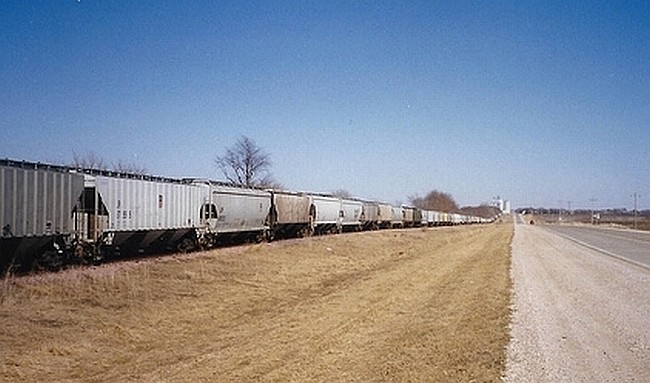
(several photos courtesy of Hank Zaletel)
This 2000 image shows the railway between Jewell and
Ellsworth, along Highway 175.
| From UNION PACIFIC - There was a decision to abandon
the Ellsworth Industrial Lead, a 3.2-mile line of railroad, between
milepost 0.0, near Jewell, and milepost 3.2, at Ellsworth in Hamilton County,
Iowa, to be effective on April 28, 2006.
(STB Docket No. AB-33 (Sub-No. 175X), decided March 17, served
March 29, 2006)
|
That report meant that the railroad track (both the
rails and the ties) were scheduled to be removed from between Jewell and
Ellsworth. And they were, indeed, removed. The
tracks west of Jewell and Stanope and east of Ellsworth and Radcliffe were
also removed. No more east-west track
When
you see the photos at the bottom of this page, you will know that portions
of that track still exist today.
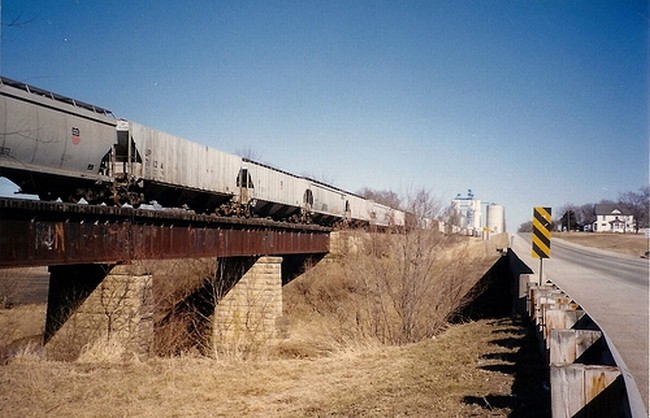
Crossing the South Skunk River bridge
This is how Ellsworth looks when heading East on Iowa
Highway 175.
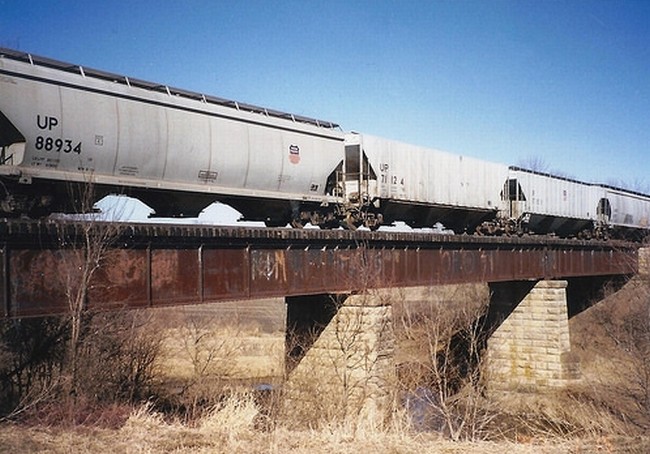
South Skunk River bridge detail

The South Hamilton Record News of June 7, 2006
had the following article as one of many pages telling a portion of the
history of Jewell. This article also describes many of the facts
that also started the settlement of Callanan and the town of Ellsworth.
|
The text of this Page 7 is included below the 2006 article.
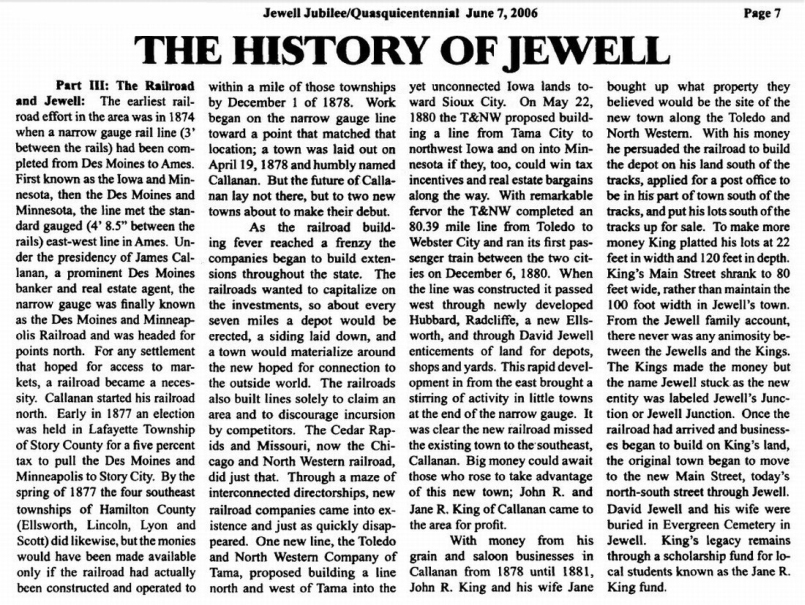
(click to enlarge this article) from the Jewell Jubilee/Quasquicentennial
- June 7, 2006)
The HISTORY OF JEWELL
Part III: The Railroad
and Jewell: The earliest railroad effort in the area
was in 1874 when a narrow guage rail line (3 feet between the rails) had
been completed from Des Moines to Ames. First known as the Iowa and
Minnesota, then the Des Moines and Minnesota, the line me the standard
gauged (4' 8.5" between the rails) east-west line in Ames. Under the presidency
of James Callanan, a prominent Des Moines banker and real estate agent,
the narrow gauge was finally known as the Des Moines and Minneapolis Railroad
and was headed for points north. For any settlement that hoped for
access to markets, a railroad became a necessity. Callanan started
his railroad north.
Early in 1877, an
election was held in Lafayette Township of Story County for a five percent
tax to pull the Des Moines and Minneapolis to Story City. By the
spring of 1877, the four southeast townships of Hamilton County (Ellsworth,
Lincoln, Lyon and Scott) did likewise, but the monies would have been made
available only if the railroad had actually been constructed and operated
to within a mile of those townships by December 1 of 1878.
Work began on the narrow gauge line toward a point that matched that location;
a town was laid out on April 19, 1878 and humbly named Callanan.
But the future of Callanan lay not there, but to two new towns about to
make their debut.
As the railroad building
fever reached a frenzy, the companies began to build extensions throughout
the state. The railroads wanted to capitalize on the investments, so about
every seven miles, a depot would be erected, a siding laid down, and a
town would materialize around the new hoped for connection to the outside
world. The railroads also built lines solely to claim an areaa
and to discourage incursion by competitors. The Cedar Rapids
and Missouri, now the Chicago and North Western railroad, did just that.
Through a maze of interconnected directorships, new railroad companies
came into existence and just as quickly disappeared. One new
line, the Toledo and North Western Company of Tama, proposed building a
line north and west of Tama into the yet unconnected Iowa lands toward
Sioux City. On May 22, 1880, the T&NW proposed building
a line from Tama City to northwest Iowa and on into Minnesota if the, too,
could win tax incentives and real estate bargains along the way.
With remarkable fervor, the T&NW completed an 80.39 mile line from
Toledo to Webster City and ran its first passenger train between the two
cities on December 6, 1880. When the line was constructed,
it passed west through newly developed Hubbard, Radcliffe, a new Ellsworth,
and through David Jewell enticements of land for depots, shops and yards.
This rapid development in from the east brought a stirring of activity
in little towns at the end of the narrow gauge. It was clear
the new railroad missed the existing town to the southeast, Callanan.
Big money could await those who rose to take advantage of this new town;
John R. and Jane R. King of Callanan came to the area for profit.
With money from his
grain and saloon businesses in Callanan from 1878 until 1881, John R. King
and his wife, Jane, brought up what property they believed would be the
site of the new town along the Toledo and North Western. With his money,
he persuaded the railroad to build the depot on his land south of the tracks,
applied for a post office to be in his part of town south of the tracks,
and put his lots south of the tracks up for sale. To make more
money, King platted his lots at 22 feet in width and 120 feet in depth.
King's Main Street shrank to 80 feet wide, rather than maintain the 100
foot width in Jewell's town. From the Jewell family account,
there never was any animosity between the Jewells and the Kings.
The Kings made the money, but the name Jewell stuck as the new entity was
labeled Jewell's Junction of Jewell Junction. Once the railroad
had arrived and businesses began to build on King's land, the original
town began to move to the new Main Street, today''s north-south street
through Jewell. David Jewell and his wife were buried in Evergreen Cemetery
in Jewell. King's legacy ramains through a scholarship fund
for local students known as the Jane R. King fund.
|

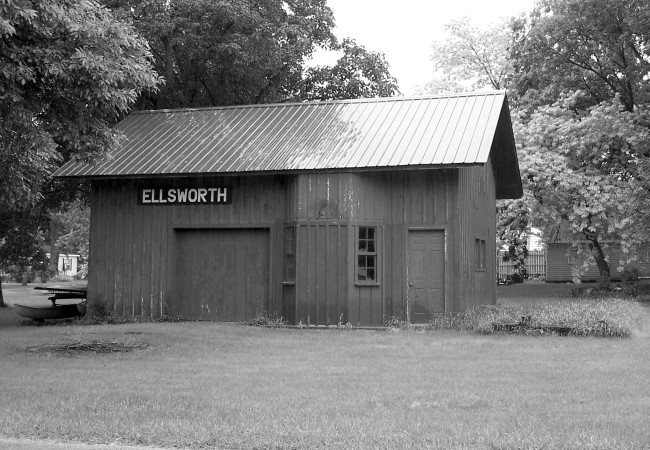
You may notice something in
the tall grass at the right (south) side of the depot in Ellsworth.
The grass covers a bit of railroad track from the Ellsworth line.
A few years after the depot was placed in it's new location, the railroad
line was removed from between Stanhope, Jewell and Ellsworth, and Radcliffe.
Of course, no more trains would ever again come though Ellsworth, because
there are no tracks.
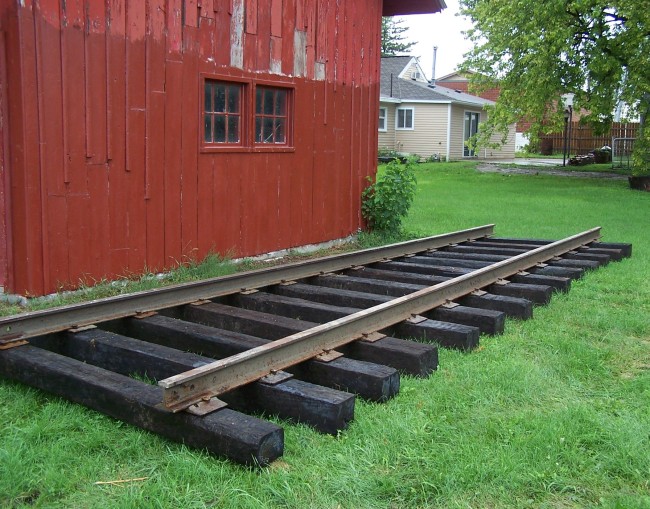
When the tracks were removed from
the Ellsworth area, the removal crew was asked if they could please
save
a piece of track to accompany the community Depot instead of "recycling"
all of it. The crew was tired and didn't make any promises,
but at the end of their long day, they brought two 35 foot rails and many
ties. They constructed this set of tracks beside the Callanan/Ellsworth
Depot, and it remains there today.
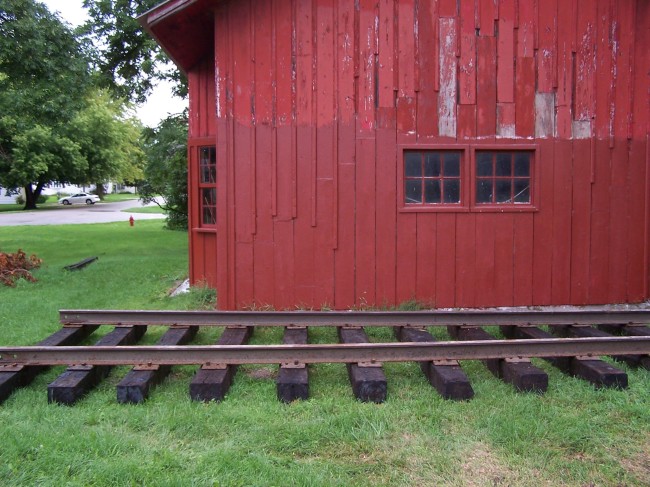
The tracks are placed running east and west, just like
the original tracks had run through Ellsworth. Because the Depot
at this location was turned 90 degrees from how it originally had been
positioned, the ticket window no longer faces the tracks as it did when
this building was a proper Ellsworth railroad station for one hundred years.
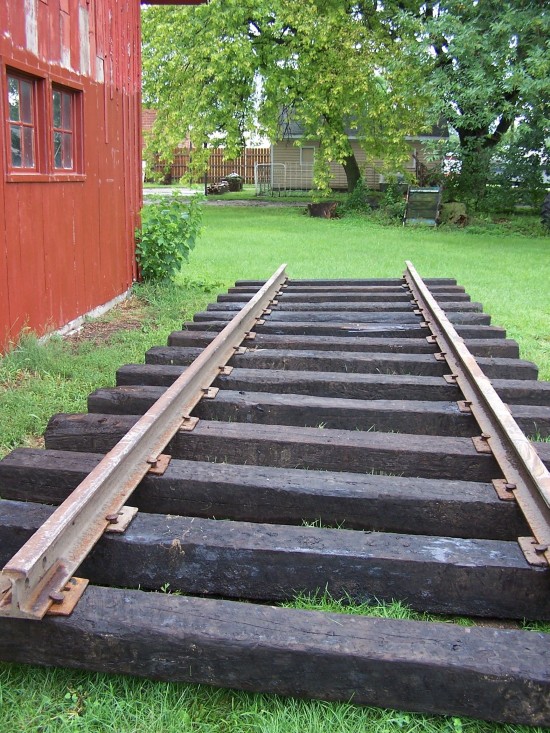
No trains today!
(or tomorrow either, of course)
How is the Ellsworth Depot used today?
Go to Page 10B
back
Home
|

